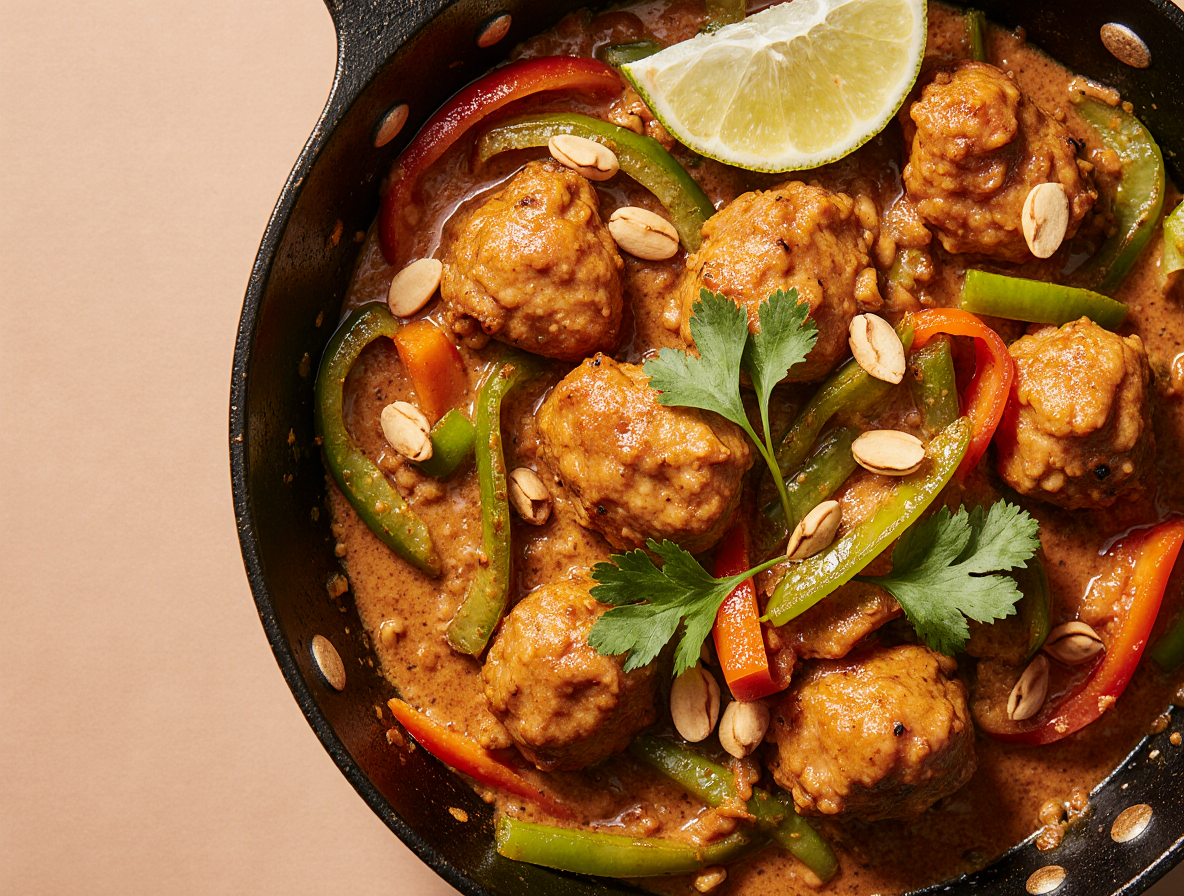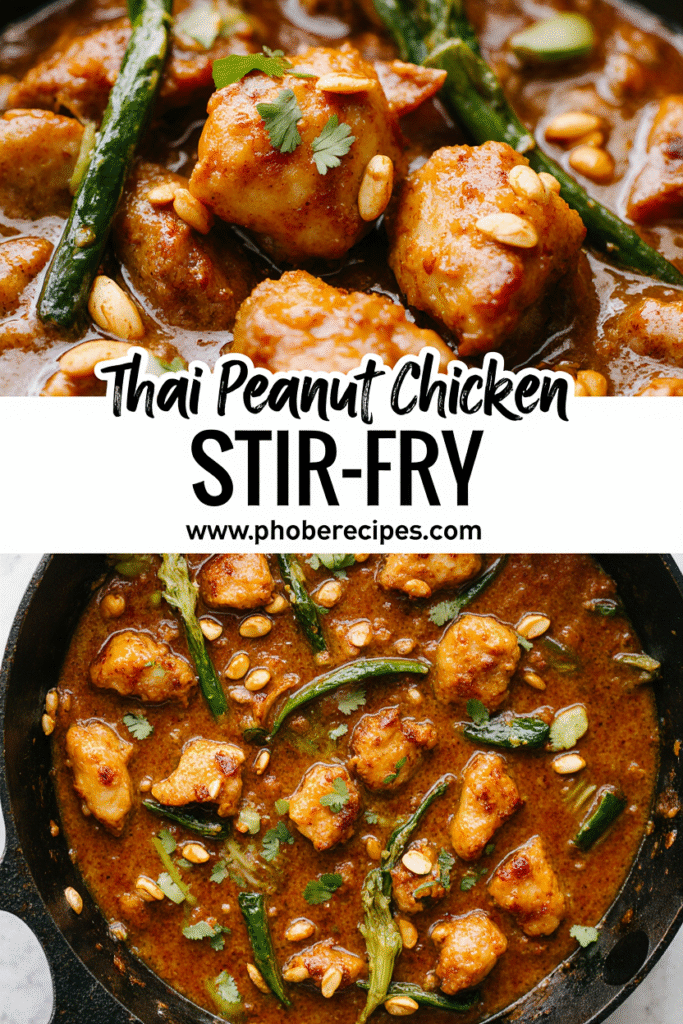How to Make Perfect Thai Peanut Chicken Stir-Fry (Easy One-Pan Recipe)
Chicken peanut stir fry might just be the recipe that changes your dinner game forever—it certainly worked for cookbook author Erin, whose Thai-inspired recipe allegedly got her married! I’ve found that this mouthwatering combination of tender chicken, colorful vegetables, and rich peanut sauce creates a meal that’s not only delicious but also incredibly practical.
This Thai peanut chicken recipe is a true 30-minute wonder that goes from prep to plate with minimal effort. The peanut sauce stir fry base transforms ordinary ingredients into something extraordinary, while still keeping things budget-friendly and nutritious. In fact, each serving packs an impressive 28g of protein and 6g of fiber, making it both satisfying and wholesome. Whether you’re cooking for yourself or your family, this chicken peanut sauce stir fry combines familiar ingredients with Thai-inspired flavors to create a meal everyone will love.
First thing to remember, you don’t need to be a culinary expert to master this dish. Throughout this guide, I’ll walk you through every step of creating the perfect one-pan Thai peanut stir fry, from selecting ingredients to customizing it to your preferences.
Essential Ingredients for Thai Peanut Chicken Stir-Fry
The perfect thai peanut stir fry begins with gathering quality ingredients. Creating this delicious one-pan meal requires three distinct component groups, each contributing to the rich, complex flavor profile that makes this dish so crave-worthy.
For the peanut chicken sauce
At the heart of any authentic thai peanut chicken recipe is its signature sauce. Creamy peanut butter forms the foundation, providing richness and body. For best results, choose a smooth variety without added sugars or oils.
Balance comes from sweetening agents—either honey (2-3 tablespoons) or brown sugar (1-2 tablespoons) works perfectly. For the essential salty element, low-sodium soy sauce adds umami depth without overwhelming saltiness. Those requiring gluten-free options can substitute tamari.
What gives peanut chicken sauce its distinctive Thai character is red curry paste (2-3 tablespoons), which imparts complex spice notes. The sauce needs acidity to cut through richness—rice vinegar accomplishes this beautifully, though some recipes use lemon juice or apple cider vinegar as alternatives[52].
Fresh minced garlic and ginger provide aromatic punch—approximately 1-2 cloves of garlic and 1 tablespoon of ginger creates balanced flavor[53]. For heat customization, add red pepper flakes or Sriracha to taste[54].
For the stir-fry base
The foundation begins with a suitable cooking oil. While olive oil is commonly used, other options include canola, peanut, or sesame oil for additional flavor notes[53].
Boneless skinless chicken is the protein star—about 1 pound per recipe, cut into bite-sized pieces[53]. Breasts work well, but thighs offer more moisture and flavor.
A colorful vegetable medley makes this dish nutritionally complete. Popular choices include thinly sliced onions, broccoli florets, cabbage (napa or purple for color variation), carrots, bell peppers, sugar snap peas, and mushrooms[52][53]. The beauty of chicken peanut sauce stir fry is its adaptability—you can use approximately 6 cups of vegetables of your choosing.
Optional toppings and garnishes
Elevate your peanut sauce stir fry with thoughtfully chosen garnishes. Chopped dry-roasted peanuts (about ½ cup) add wonderful textural contrast[53]. Fresh herbs like cilantro (or parsley for cilantro-averse diners) and Thai basil provide brightness and aroma.
Sliced green onions contribute mild onion flavor and visual appeal[71]. For additional texture and nutty notes, sprinkle with sesame seeds[71]. A squeeze of fresh lime brightens all flavors.
Additionally, some cooks enjoy adding crunchy elements like wonton strips or chow mein noodles for textural interest.
Step-by-Step Cooking Instructions
Now that we’ve assembled our ingredients, let’s transform them into a mouthwatering chicken peanut stir fry. The beauty of this one-pan meal lies in its straightforward preparation process that yields restaurant-quality results.
1. Make the peanut sauce
Creating the signature sauce for your thai peanut chicken recipe begins with combining all sauce ingredients in a medium bowl. Whisk together peanut butter, soy sauce, rice vinegar (or lemon juice), honey (or brown sugar), sesame oil, ginger, garlic, and hot sauce until smooth and well-incorporated. For ultra-smooth results, you have three options:
- Whisk by hand for a naturally textured sauce
- Shake vigorously in a jar with a tight-fitting lid
- Blend in a food processor for the creamiest consistency
If your sauce appears too thick, gradually add warm water (1-2 tablespoons at a time) until you reach your desired consistency. Set aside while you prepare the other components.
2. Cook the chicken until golden
Heat a large skillet or wok over medium-high heat and add 1-2 tablespoons of oil. Once the oil is hot (almost smoking), add your chicken pieces in a single layer. For optimal results:
- Avoid overcrowding the pan – cook in batches if necessary
- Season chicken with salt and pepper to taste
- Stir-fry until fully cooked through and juices run clear (approximately 4-5 minutes)
Once golden and cooked through, transfer chicken to a clean plate and set aside.
3. Stir-fry the vegetables
Using the same pan, add another tablespoon of oil if needed. Next:
- Start with hardier vegetables like onions, cooking until fragrant (2-3 minutes)
- Add garlic and ginger (cook for just 30 seconds to prevent burning)
- Introduce colorful vegetables like bell peppers, broccoli, carrots, and sugar snap peas
- Cook until vegetables are crisp-tender (3-5 minutes depending on your selection)
4. Combine everything and simmer
The final stage brings all elements together:
- Return the cooked chicken to the pan with the vegetables
- Pour the peanut sauce over everything
- Toss gently to coat all ingredients evenly
- Bring to a low simmer and cook for 1-3 minutes until heated through and slightly thickened
Upon serving, your chicken peanut sauce stir fry will showcase vibrant colors and enticing aromas. The sauce should cling beautifully to both chicken and vegetables, creating the perfect balance of flavors in every bite.
Tips for a Perfect One-Pan Stir-Fry
Making the perfect chicken peanut stir fry requires more than just following a recipe. These insider tips will elevate your one-pan meal from good to restaurant-quality.
Use frozen veggies to save time
Pressed for time? Frozen vegetables are your secret weapon for quick thai peanut chicken. They’ll cut your prep time in half while still delivering delicious results. Simply thaw and pat dry before adding to your hot pan. Although frozen veggies won’t retain the same crisp texture as fresh ones, they’re perfect for busy weeknights when convenience matters. Furthermore, many grocery stores offer stir-fry specific blends with pre-cut vegetables ready to go straight from freezer to wok.
Cook chicken in batches for better sear
One common mistake that prevents your chicken peanut sauce stir fry from reaching its full potential is overcrowding the pan. When too much chicken hits the pan simultaneously, the temperature drops dramatically, resulting in steamed rather than seared meat. Instead, divide your chicken into 2-3 batches, giving pieces room to develop that beautiful golden exterior. Subsequently, your chicken stays tender inside while developing flavor-enhancing caramelization outside. Between batches, allow your pan to regain its heat for consistent results.
Add garlic and ginger last to avoid burning
Despite being essential flavor builders in thai peanut stir fry, garlic and ginger burn easily and develop bitter flavors when overcooked. Rather than adding them at the beginning, incorporate these aromatic ingredients during the last 30-60 seconds of cooking your vegetables. Essentially, this timing ensures they release their fragrant oils without becoming acrid. Remember that properly cooked aromatics should smell sweet and inviting, never charred.
Adjust spice level to your taste
The beauty of homemade peanut sauce stir fry lies in customization. Too spicy? Reduce or omit red pepper flakes entirely. Craving more heat? Increase the spice gradually through additional chili flakes, Sriracha, or garlic chili sauce. Alternatively, balance intense heat by adding cooling elements like lime juice or coconut milk. This flexibility ensures everyone at your table enjoys their perfect spice level.
Customizations and Variations
One of the greatest advantages of this thai peanut stir fry is its incredible adaptability. Whether accommodating dietary restrictions or simply working with ingredients you have on hand, this recipe welcomes creative variations.
Make it vegetarian or vegan
Creating a plant-based version of this dish requires minimal adjustments. Replace chicken with tofu for a protein-rich alternative that absorbs the peanut sauce beautifully. For a complete vegan transformation, swap honey for maple syrup or agave in the sauce. Beyond tofu, consider adding chickpeas, tempeh, or additional vegetables to maintain protein content. The robust peanut sauce ensures your meat-free version remains satisfying and flavorful.
Use noodles instead of rice
While rice provides a traditional base, noodles offer an exciting textural contrast with the peanut sauce stir fry. Brown rice noodles work perfectly for a hearty option, whereas konjac noodles create a lower-carb alternative. Moreover, experimenting with udon, soba, or even sweet potato noodles introduces entirely new flavor profiles. Plus, noodles often cook more quickly than rice, making weeknight meal preparation even faster.
Try different vegetables
The beauty of chicken peanut sauce stir fry lies in its vegetable versatility. Undoubtedly, heartier vegetables like carrots, bell peppers, and broccoli hold up well to stir-frying. Accordingly, cook these first before adding more delicate options. Alternative choices include bok choy, snap peas, mushrooms, zucchini, cauliflower, or even eggplant. This adaptability makes the dish perfect for using whatever produce you have available, reducing food waste and grocery expenses.
Swap chicken breasts for thighs
For a juicier variation of thai peanut chicken recipe, substitute chicken thighs for breasts. Thighs contain more fat, resulting in more flavorful and moisture-rich meat. They’re also more forgiving if slightly overcooked, making them ideal for stir-fry beginners. Remember that thighs typically require an additional minute or two of cooking time compared to breast meat.
Make it gluten-free with tamari
Transforming this recipe into a gluten-free option is straightforward – simply replace soy sauce with tamari in the peanut sauce. In addition to tamari, coconut aminos provide another gluten-free alternative with a slightly sweeter profile. Remember to check your red curry paste as well, as some brands contain gluten-based ingredients.
Conclusion
Thai peanut chicken stir-fry truly stands as one of the most versatile dishes you can add to your weeknight dinner rotation. Throughout this guide, we’ve explored how this one-pan wonder delivers exceptional flavor while remaining surprisingly simple to prepare. The rich, creamy peanut sauce transforms ordinary ingredients into an extraordinary meal that rivals restaurant quality.
Many home cooks shy away from Thai-inspired dishes, assuming they require specialized ingredients or techniques. However, as you’ve seen, this recipe uses accessible components while still delivering authentic flavors. Additionally, the customization options make this dish adaptable to virtually any dietary preference or restriction.
Time constraints often dictate our cooking choices, yet this 30-minute meal proves you don’t need hours in the kitchen to create something delicious. The protein-packed combination of tender chicken and colorful vegetables provides both satisfaction and nutrition. Furthermore, the tips we’ve shared about batching your chicken and timing your aromatics will help ensure perfect results every time.
Perhaps the greatest strength of this recipe lies in its flexibility. Whether you prefer noodles over rice, need a vegetarian option, or simply want to use whatever vegetables are in your refrigerator, this dish accommodates all these variations beautifully. Above all, cooking should bring joy rather than stress, and this adaptable recipe certainly delivers on that promise.
Next time you’re wondering what to make for dinner, remember this Thai peanut chicken stir-fry. Once you master the basic technique, you’ll find yourself returning to this recipe again and again, each time with delightful new variations. Certainly, your family and friends will appreciate both the flavors and the care you’ve put into creating such a satisfying meal. Give it a try tonight – your taste buds will thank you!
FAQs
Q1. What are the key ingredients in Thai peanut sauce? Thai peanut sauce typically consists of peanut butter, soy sauce, rice vinegar, honey or brown sugar, sesame oil, ginger, garlic, and hot sauce. Some variations may include coconut milk or lime juice for added flavor.
Q2. Which vegetables work best in Thai peanut chicken stir-fry? Popular vegetables for Thai peanut chicken stir-fry include broccoli, carrots, bell peppers, onions, sugar snap peas, and mushrooms. You can also experiment with bok choy, zucchini, or cauliflower for variety.
Q3. How can I enhance the flavor of my stir-fry? To make your stir-fry taste amazing, add a splash of tangy ingredients like lime juice or rice vinegar. Using fresh garlic and ginger can significantly boost flavor. Also, cooking chicken in batches helps develop a better sear and enhances overall taste.
Q4. Can I use chicken thighs instead of breasts in this recipe? Yes, you can swap chicken breasts for thighs in this recipe. Chicken thighs are juicier and more flavorful due to their higher fat content. They’re also more forgiving if slightly overcooked, making them ideal for stir-frying.
Q5. How can I make this Thai peanut chicken stir-fry vegetarian or vegan? To make the dish vegetarian or vegan, replace chicken with tofu, tempeh, or additional vegetables. For a vegan version, also substitute honey with maple syrup or agave in the sauce. You can add chickpeas or other plant-based proteins to maintain the protein content of the dish.


